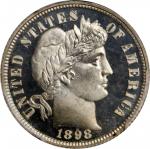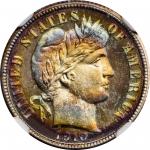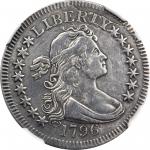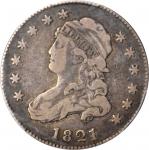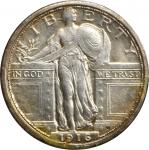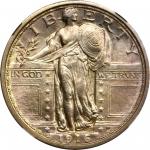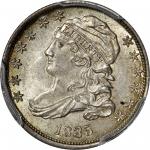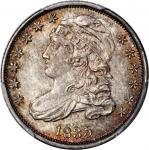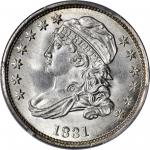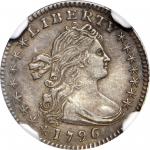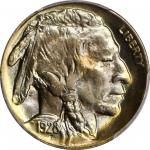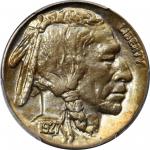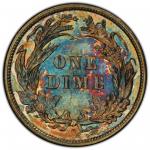1894-S年巴伯25美分 PCGS Proof 63
1894-S Barber Dime. Branch Mint Proof-63 (PCGS). CAC.The 1894-S Barber dime. The 1894-S dime. The 94-S. The mere mention of this coin, whether by its full description or the most minimal of abbreviations, is enough to catch the attention of even casual collectors of United States coinage. It is one of the classic rarities in all of numismatics, a legendary coin in the same league as the 1804 silver dollar and 1913 Liberty Head nickel. Indeed, legend has long surrounded the 1894-S dime; the yarns that have been spun to explain its production, distribution and the discovery of individual examples are as captivating to collectors as its undeniable rarity. Modern numismatic scholarship has shed much needed light on this issue, but while the true story of its creation is not as dramatic as the various theories and myths that have cropped up over the years, the issue has lost none of its mystique. Todays collectors, when dreaming about the 1894-S dime -- even though they may be familiar with the facts -- cannot help but let their minds wander to the stories of yesteryear that have become part of the legend. The stories that kindled excitement in the minds of earlier generations of numismatists researching or discussing the 1894-S dime, are the same stories that will continue to fascinate and bring a smile to the faces of future generations of collectors when their curiosity is piqued for the first time. There are many reasons why the 1894-S Barber dime is ranked No. 6 in the popular and influential reference 100 Greatest U.S. Coins by Jeff Garrett and Ron Guth (second edition published 2005). It is likely that any collector could name the coins that beat it out for the top five rankings: the King of American Coins, the 1804 silver dollar; the 1913 Liberty Head nickel, of which only five are known; the mysterious 1933 Saint-Gaudens double eagle, the only example considered legal to own once being the central player in a U.S. government sting operation; the historic and unique 1849 pattern Liberty Head double eagle in the National Numismatic Collection at the Smithsonian Institution; and the MCMVII Ultra High Relief Saint-Gaudens double eagle, widely regarded as the most beautiful coin ever struck in the United States Mint. The 1894-S dime is clearly in very select company at the apex of U.S. numismatics. First and foremost among the reasons that secured the 1894-S dime the No 6. ranking in the 100 Greatest U.S. Coins book is its formidable rarity. For most numismatists, dreaming about, casually discussing, or researching are as far as they will be able to go with the 1894-S dime. For starters, only 24 examples were struck with a net mintage of just 21 coins after three were assayed. As of this writing, only nine specimens are positively confirmed to exist, and the ownership of one of these special coins is enough to elevate one to the numismatic peerage. Fortunate is the numismatist -- professional or private collector -- who has the opportunity to even gaze upon one of these coins in real life or to hold it in their hands even for a minute or two. Market appearances are few and far between, for 1894-S dimes have traditionally spent years, if not decades, in tightly held collections. Even collectors with sufficient funds to acquire an 1894-S dime are often delayed in, if not denied, realizing their dream for lack of a buying opportunity. The specimen offered here, in fact, is making its first market appearance in 31 years -- all the proof needed to recognize the important bidding opportunity that this offering represents. Also crucial to the desirability and popularity of this issue are the theories, stories and myths that comprise the lore of the 1894-S dime. So entrenched is the legend of this dime in traditional numismatic wisdom, that we begin our deeper discussion with the more popular theories surrounding its creation and the existence of a few of the survivors. Creation of a Rarity: The Theories Over the years a number of theories have been advanced to explain the striking of just 24 dimes at the San Francisco Mint in 1894. Four of these theories have proved particularly popular with numismatic researchers. Theory No. 1 - - Closing out a Bullion Account One of the earliest theories advanced to explain the striking of just 24 dimes at the San Francisco Mint in 1894 originated with Farran Zerbe (former president of the American Numismatic Association), and was published in the April 1928 issue of The Numismatist, Volume XLI. In an article titled Two Extreme Rarities in Recent U.S. Coinage, Zerbe is quoted as follows: To close a bullion account at the San Francisco Mint at the end of the fiscal year, June 30, 1894, it was found necessary to show 40 cents, odd in the years coinage. The mint not having coined any dimes during the year, the dime dies were put to work, and to produce the needed 40 cents, 24 pieces were struck, any reasonable amount of even dollars over the 40 cents being readily absorbed in the account. It has been stated that at the time no thought was given by the mint people that a rarity has been produced, it being supposed that they would, as always in the past, be ordered to coin dimes before the close of the year. It so happened that no dime coinage was ordered and the unintentional error was not realized until the years coinage record was closed. It is said that two or three of the pieces were obtained by mint people at the time of coinage, just to have a new dime, and following the disclosure of rarity these were sold to collectors for $25 or more a piece. Except these two or three pieces, the coinage is said to have gone into a bag with other dimes and is supposed to have passed from the mint for circulation. I do not know of prices. One of the stories I have heard is of a barber in Olean, N.Y., who for years had been kidded by his friends for scrutinizing every dime that came his way for 1894 and the S mint mark, was eventually rewarded for discovering one, which was sold for $100. My information about the limited coinage was obtained at the San Francisco mint in 1905. Zerbes source at the San Francisco Mint in 1905 was almost certainly Charles Gorham, the facilitys melter and refiner at that time, who had held the position of chief coiner in 1894 when the dimes were struck. Gorham is certainly a reputable source in this context, which has helped make this theory popular with numismatic scholars. Theory No. 2 - Assay This theory first gained widespread exposure in the early 20th century, when Edgar H. Adams wrote a column on numismatics titled Few Finds of Rare Coins that appeared in the March 29, 1908 issue of the New York Sun. An excerpt from this column is included in Q. David Bowers new (2019) edition of A Guide Book of Barber Silver Coins for Whitman: There are right now in active circulation several issues of United States coins which if found by the average citizen would make the time he spends in glancing through his change profitable. One of these is the United States dime dated 1894 that were was struck at the branch mint in San Francisco. The coin bears on the reverse the little mint letter S to distinguish it from all the other ten cent pieces of the year. Yet while the rest of the dimes exist in considerable numbers and are worth but their face value, the San Francisco dime would easily bring $50. The available information regarding the coin shows that but twenty-four of the denomination were made in 1894. This figure is only an estimate, for the actual number does not appear in the records. That so few were coined was due to a peculiar circumstance. Weigher [Frank C.] Berdan, now in the coiners department of the San Francisco Mint, says that in July 1894 an order for $100,000 worth of silver coins had been completed and was ready for delivery. In order to provide specimens for assay purposes, the law requiring that a certain number of pieces from each melt, or order, be forwarded to the Mint headquarters for the purposes of annual assay, Mr. Berdan had the coining department strike a number of pieces from the dime dies. He says there may have been twenty-four of these and there may have been less, probably not over twenty, as the matter of counting them was not deemed to be of importance. Two or three pieces in fact, he said, would have answered the requirements just well. He took a couple of ordinary dimes from his pocket and exchanged them for two of the new ten cent pieces merely from a desire to possess the first specimens that had come from the dies of this denomination for the year. He said that the idea of the dimes ever becoming scarce never entered his mind, for an order for 100,000 pieces might be expected any day, and no one would have imagined that the entire year would pass without the dies again being brought into requisition. Yet 1894 did pass without any more coins of the denomination being struck there, and the only dimes dated 1894 and showing the S mint mark were the two pieces referred to, which afterward fell into the hands of a well-known mint mark collector. The remainder of the pieces are right at the present moment passing from hand to hand, their temporary owners not being aware of their value to a coin collector. The above would seem to indicate that no other San Francisco Mint officials obtained any at the time. As with Zerbes source for Theory No. 1 outlined above, Adams source for Theory No. 2 is also reputable: Frank C. Berdan, who was employed as weigher at the San Francisco Mint when the 1894-S dimes were produced. A number of points in Berdans account, as related by Adams, are certainly true, and his position at the San Francisco Mint in 1894 has also helped to give the assay theory traction in numismatic literature. However, the assay of coins struck in the mints was a normal part of the coinage process during the 1890s. Coins were struck, and then certain ones were set aside for assay. No one at the San Francisco Mint in 1894 would have struck any coins expressly for assay, not three coins, 24, or any other quantity. To do so, in a sense, would have been putting the cart before the horse and would have been contrary to mint practice at the time. It is also worth noting in connection with this theory that it was once thought that five 1894-S dimes had been reserved for assay, the two additional coins supposedly collected from the cashier at the San Francisco Mint on June 25, 1894 as part of the monthly assay. Thanks to recent research done by Nancy Oliver and Richard Kelly, however, we now know that those coins referred to two of the three examples sent to the East Coast. Additional coins were not reserved on a monthly basis for assay at the San Francisco Mint in 1894. Theory No. 3 - Sale to Collectors for a Profit Such a practice is certainly not without precedent in the history of the United States Mint in the years leading up to 1894. During the tenures of James Ross Snowden (1853 to 1861) and Henry R. Linderman (1867 to 1869 and 1873 to 1878) as mint director, in particular, many famous restrikes, mulings, and fantasy pieces were produced expressly for sale to contemporary collectors for profit (to say nothing of the host of so-called patterns made during the late 1860s and 1870s that were also sold to contemporary collectors as part of pattern Proof sets). In addition to the mintage of just 24 coins, the fact that numismatic tradition regards all 1894-S dimes as Proofs would seem to support the theory that these coins were specially prepared for sale to collectors. There is, however, a significant difference between the 1894-S dime and these other coins: the 24-coin mintage, paltry as it is, was duly recorded in Mint records and listed in the Report of the Director of the Mint for 1895 in the table on pages 212 to 213. This means that the 1894-S is a regular issue United States Mint coin, which is further confirmed by the fact that most of the 24 examples produced were forwarded to Chief Coiner Charles Gorham for distribution into circulation. Theory No. 4 - John and Hallie Daggett and the Ice Cream Story This is the most famous story about the 1894-S dime, the one with which most collectors of U.S. coins are familiar. This theory traces its origins to an article that James Johnson wrote for the September 1972 issue of Coin World in which he attempted to compile all information about the 1894-S dime and present a roster of examples known at that time. In response, Johnson received a letter from a Guy Chapman that prompted him to update his story on the 1894-S dime in the June 27, 1973 issue of Coin World: Guy L. Chapman of California wrote that one evening in 1954, the late Earl Parker came into the Redwood Empire Coin Club and put two dimes in Chapmans hand. They were the two 1894-S dimes Parker had just acquired from Hallie Daggett, daughter of the San Francisco Mint superintendent in 1894. Parker offered them to Chapman, but Chapman said he had to check with his wife before spending that kind of money! When he got home, he and his wife agreed that he should buy them, but it was very late and he didnt want to call Parker at that time of night. He would call at 9 oclock the next day. Chapmans birth year was 1894, one reason for the interest. He did call, and Parker told him he had sold the coins before breakfast. Presumably they were Nos. 5 and 9 in my earlier Coin World listing. Heres the important part: at the Redwood Empire Coin Club Parker repeated what Hallie Daggett had told him when he bought the coins from her. She said this: In 1894 a banker friend of Daggetts found there would be no dimes struck that year. So he asked Daggett to make some pieces especially for a small group of friends. There were 24 struck, and eight of eight people got three including Daggett. Daggett gave three to his daughter Hallie who was around and told her to put them away until she was as old as he was, and then she could sell them for a good price. On the way home she spent one for a dish of ice cream. The other two she put away until she sold them to Earl Parker in 1954. What is not known is who the other seven people were or whether they were connected with the mint in any way, There is no reason to disbelieve Hallie Daggetts story. There is every reason to believe that later the Mint would say anything rather than admit what was done, hence the conflicting reports given out in the later years. Walter Breen picked up this story and published it in his numismatic works. The version in his 1988 Complete Encyclopedia of U.S. and Colonial Coins reads: However, the most famous of all Barber dimes is beyond doubt the 1894-S. Of only 24 minted (all as proofs), reported June 30, 1894, only a dozen are traced. These were special strikings made by Mint Superintendent J. Daggett for a group of banker friends. Each of eight persons received three; Daggett gave his three to daughter Hallie, telling her to put them away until she was as old as he was, at which time she would be able to sell them for a good price. On the way home, the child supposedly spent one for a dish of ice cream, but kept the other two until 1954, when she sold them to the coin dealer Earl Parker. As Parker had three, someones memory is evidently at fault. Breens writings have helped to make this one of the most widely disseminated stories about the 1894-S dime, aided greatly by the wonderful tale of a young girl receiving three shiny new coins as a gift from her Mint superintendent father, being told to keep them until a ripe old age, and then proceeding to immediately spend one of them on a dish of ice cream on her way home from the Mint on a hot day. What Really Happened: Inadvertent Creation of a Rarity The true story of the 1894-S Barber dime begins as it does for most regular issue United States Mint coins. After producing 2,491,401 dimes during calendar year 1893, the staff at the San Francisco Mint had every reason to believe that they would also be producing a generous number of dimes the following year. Indeed, the West Coast facility received five pairs of 1894-dated dime dies from the Philadelphia Mint in November of 1893, followed by another five pairs in January of 1894. As it turned out, however, 1894 was the second year in the serious economic depression that is known to history as the Panic of 1893. Affecting every sector of the United States economy, the Panic of 1893 would last until 1897. By 1894 the economy had already shrunk to the point where there was little need for new circulating coinage and, indeed, nearly half of the year passed with the dime presses in the San Francisco Mint remaining idle. On April 7, 1894, the sub-treasury in San Francisco delivered to the Mint nearly $1 million in uncurrent and/or damaged coins. This was normal procedure for all United States mints at the time; the coins that they received in that manner were eventually melted and struck into new coins. According to Richard G. Kelly and Nancy Y. Oliver in the reference Gold In His Veins: The story of John Daggett, Early California Mine Owner, Mint Master, Lieutenant Governor & More: The uncurrent coinage included: $524,000 in half dollars, $273,000 in quarters, $40 in twenty cent pieces, $201,230 in dimes, $1,225 in half dimes, and $5.00 in three cent pieces. Later, the transfer amount in coin was found to be slightly more than previously noted, as $23.50 more of half dollars, and $6.50 in quarters were added. Beginning some time in May or early June, this mass of unacceptable silver coin was melted, made into silver bars, which were eventually made into new silver coin of most denominations. It is assumed that at least dollars, halves, and quarters were made from the reprocessed silver, but after all was said and done, there was still a small portion of silver bullion left. This small portion is highly significant for the story of the 1894-S dime, for it is the silver from which these rare coins were eventually struck. Confirmation of both the recoinage process and the 24-coin mintage of the 1894-S dime is provided by San Francisco Mint Chief Clerk Robert Barnett, who provided the following information to a reporter for the San Francisco Bulletin in October of 1895: All undercurrent subsidiary coins, viz., those containing other than the design now being used when received at the sub-treasury, are not again allowed to go into circulation, but are sent to the mint to be recoined with the current design. In the course of the year 1894 we received a large sum in these coins, but having an ample supply of dimes on hand, it was not intended to coin any of that denomination in 1894. However, when nearly all of this subsidiary coin bullion had been utilized, we found on our hands a quantity that would coin to advantage only into dimes and into dimes it was coined, making just twenty-four of them. Despite his official title of chief clerk, Barnett was actually serving as the acting superintendent of the San Francisco Mint in 1894. The actual superintendent, John Daggett, was kept from fulfilling his duties for much of the year due to frequent bouts of sciatica, as well as trips to check on mines in which he had financial interests and other reasons. Barnett, therefore, was the one person at the San Francisco Mint in 1894 who would know better than anyone how many 1894-S dimes were struck and the circumstances under which they were produced. Two pieces of official correspondence from Acting Superintendent Barnett to other Mint officials on the East Coast confirm that the staff in San Francisco followed the normal procedure at the time regarding the assay of coins struck in the various United States mints. The first letter, dated June 9, 1894, is from Barnett to Director of the Mint Robert Preston in Washington, D.C. As presented in Kevin Flynns 2005 reference The 1894-S Dime: A Mystery Unraveled: June 9th 1894. Hon. R.E. PrestonDirector of the MintWashington, D.C Sir:-I forward to your address to-day per registered mail one dollar and seventy cents, in coins reserved for Special Assay, taken from deliveries of this date, as follows, viz:- Del. No.77. Two (2) Half Dollars = $1.00[Del. No.]78 Two (2) Quarter .50[Del. No.]79 Two (2) Dimes .20$1.70 Respectfully yours,Robt. BarnettActing Superintendent The second letter is dated June 28, 1894, again from Barnett, but this time to the superintendent of the Philadelphia Mint. A copy of this letter is also presented in Flynns reference: June 28th 1894. Supt. U.S. Mint.Philadelphia, Pa. Sir:- I forward to your address to-day per Wells Fargo [illegible] Express a box containing the following gold and silver coins reserved for annual assay from the coinage executed by this Mint during the quarter ending June 30th 1894 - viz:- 265 Double Eagles value $5300.00460 Half Dollars [value] 230.00789 Quarter [Dollars value] 197.251 Dimes [value] .10$5727.35 Respectfully yours,Robt. BarnettActing Superintendent The first letter confirms that the 1894-S dimes were struck on June 9, 1894, and both letters confirm that three specimens were taken for assay and shipped to the East Coast for that purpose. As related above in Edgar H. Adams column for the New York Sun, Weigher Frank C. Berdan obtained two of the 1894-S dimes in exchange for two older dimes merely from a desire to possess the first specimens that had come from the dies of this denomination for the year. The remaining 19 coins were forwarded to Chief Coiner Charles Gorham who, according to Farran Zerbe, may also have acquired a couple of examples for himself. The additional pieces were unceremoniously placed into a bag of earlier dated dimes and released into circulation, the entire 24-coin mintage having been recorded in Mint records and eventually listed in the Report of the Director of the Mint for 1895 in the table on pages 212 to 213. As June 1894 passed into July, Mint personnel in San Francisco had no idea that they had inadvertently created a rarity in the 1894-S dime. The staff at the West Coast mint struck these coins with the belief that additional dime coinage would be required during the second half of 1894. As it turned out, however, no more coinage for this denomination was achieved before the end of 1894, leaving a mintage of just 24 coins for the 1894-S. The net mintage is 21 coins after three examples were forwarded to the East Coast for assay. A small number (at least the two coins acquired by Weigher Frank C. Berdan) were obtained by San Francisco Mint employees, while the remaining examples were released into circulation. Although all well preserved 1894-S dimes in numismatic hands exhibit some qualities of traditional Proof coins -- namely reflective surfaces and sharply struck design elements -- there is no evidence that San Francisco Mint employees polished either the dies or planchets used to produce them. On the other hand, only a single die pair was used to strike all known examples, and the fresh state of those dies did impart a prooflike surface during the brief press run for this issue. In the end the facts speak for themselves: the reason that Acting Superintendent Robert Barnett gives for the production of these coins, and the eventual release of most examples into circulation, would not have required Mint personnel to produce anything other than circulation strikes for the 1894-S dime issue. Historically, however, the 1894-S has always been regarded as a Proof issue and, as confirmed below in our roster of known examples, PCGS and NGC certify all well preserved specimens as Proofs or Branch Mint Proofs. Early Numismatic Interest in the 1894-S Dime Although Augustus G. Heatons now famous treatise Mint Marks had been published the year before, in 1894 there were still very few numismatists in the United States who collected coins from the branch mints. Most who did acquired coins from circulation rather than obtaining Mint State examples directly from the mints. A notable exception was Pennsylvania oil man and Washington, D.C., financier John M. Clapp, who began ordering coins directly from each mint in 1893. According to Q. David Bowers: On November 2, 1894, [Clapp] wrote to San Francisco to order one example of each coin. Acting Superintendent Robert Barnett replied on November 9, stating, We have no coinage dimes 1894. Others also requested dimes directly from the San Francisco Mint in 1894, including George Eavenson of Colorado, Eugene B. Stevens of Kansas, H.M. Ensminger of Pennsylvania, Peter Mougey of Cincinnati, and even Augustus G. Heaton. The final listed received Barnetts reply to his October 30, 1894 request: We have no 10 cent pieces coinage 1894. Heaton published the earliest numismatic reference to the 1894-S dime and its rarity when he updated his 1893 Mint Marks with an article titled Late Coinage of the United States Mint that appeared in the March 1900 issue of The Numismatist: The San Francisco Mint takes proudly to itself the sensation of later U.S. coinage in striking but $2.40 worth of dimes, or 24 pieces in all, in the year 1894. Of these, the writer possesses the only one known to the numismatic world. How Heaton acquired his 1894-S dime is unknown, the later provenance of that specimen also unknown since none of the examples currently accounted for can be traced back to the famous numismatist. John H. Clapp also eventually succeeded in acquiring an 1894-S dime. By 1900, in fact, the Clapp cabinet included two examples of this famous rarity, at least one of which was acquired from a source in San Francisco, although not directly from the mint as Clapp had originally intended. Current numismatic thought is that one or both of the 1894-S dimes once owned by Clapp were the coins that Weight Frank C. Berdan obtained through exchange shortly after striking. What May Have Happened: Earl Parker and the Ice Cream Story The theory about John and Hallie Daggett and the Ice Cream Story requires closer examination, not only because it is the most famous theory about the 1894-S dime, but also because the specimen that we are offering here is one of two coins that numismatic legend attributes to Superintendent Daggett and his daughter Hallie. As intriguing and popular as it is, there are a number of problems with this story and, in short, most (although perhaps not all of it!) is untrue. For starters Hallie Daggett was 15 years old in 1894, thereby older than the little girl she is portrayed as in the account. She was also one of three surviving children of John Daggett in 1894, so why the father would chose to give all three 1894-S dimes to one child instead of giving one to each of his children is curious. More significantly, and as related above, modern numismatic scholarship has confirmed that three of the 24 1894-S dimes struck were forwarded to the East Coast for assay. The 21 remaining coins cannot be divided equitably into three coins each for eight persons. Additionally, this account does not allow for the two specimens acquired by Weigher Frank C. Berdan. The final nail in the coffin of the theory that the 1894-S dimes were specially struck by Mint Superintendent John Daggett for banker friends is the fact that Daggett was absent from his post for most of 1894. As previously confirmed, it was actually Chief Clerk Robert Barnett who, as acting superintendent, oversaw the striking of the 24 1894-S dimes. It was Barnett, and not Daggett, who signed the letters that accompanied the assay specimens to Washington, D.C., and Philadelphia, answered most of the inquiries from contemporary collectors looking for information about the 1894-S and seeking an example for their collections, and gave the first public interview about the coins to the San Francisco Bulletin in 1895. While it is obvious that Superintendent Daggett did not order a special striking of 24 1894-S dimes, there remains the fact that San Francisco dealer Earl Parker owned two of these coins during the 1950s. Parker clearly did not acquire the coins from Hallie Daggett, as the story of the young girl spending one of her three newly acquired keepsakes for a dish of ice cream on her way home from the Mint is apparently nothing more than numismatic legend. There is, however, another account of Earl Parkers acquisition of and presentation of two 1894-S dimes at a California numismatic gathering during the 1950s that lends credibility to a different version of the famous ice cream story. Kevin Flynn writes: The author spoke with Ken Jordan from California. Mr. Jordan was the President of the Rosemont Coin Club starting in 1959. Mr. Jordan was with Guy Chapman when Earl Parker came to the coin show and offered the two 1894-S dimes for sale for $500 per dime. Mr. Parker said he remembered the date Earl Parker stopped in was in 1957. At that time Guy Chapman was the President of the Rosemont Coin Club. Mr. Jordan said that he remembered holding both coins. He remembered the story that Earl Parker had told him, that he, Mr. Parker, had purchased the coins from a daughter of a banker who lived in Ukiah, CA. She had told Mr. Parker that her father had given her three coins and that she had spent one on ice cream on the way home. She was told by her father to hold the coins until she was old when they would be valuable. Mr. Jordan said that the other individual who was present was Henry Reed. There so many similarities between the Chapman and Jordan accounts that they obviously refer to the same interaction with Earl Parker, during which Parker clearly told a story about the daughter of someone receiving three of the coins from her father, spending one of them on ice cream, and keeping the other two until selling them to Parker. The missing piece of the puzzle was actually printed in the February 1951 edition of the Numismatic Scrapbook Magazine, in other words 22 years before the John and Hallie Daggett theory was put forth. Flynn again: In the February 1951 issue of the Numismatic Scrapbook Magazine, an article stated that Wm. F. Bailey of San Francisco forwarded a newspaper clipping telling of the sale, by a non-collector, of two specimens of the 1894-S dime. According to the story, back in 1894, a banker in Ukiah gave three dimes to his little daughter and told her to save them as they would some day be valuable. Then the Ukiah woman sold two of them for $2,750.00 each. The woman stated that she looked high and low for the third specimen, but finally remembered that it was a hot day in 1894 when her father gave her those dimes and she visited an ice cream parlor on the way home. Ukiah is a town in California, which is 115 miles north of San Francisco. This story did not mention Hallie Daggett as the source of the coins and this story did not mention the bankers friend theory that a banker friend of John Daggett asked Mr. Daggett to strike 1894-S dimes. The source of this story had to be Earl Parker as he is the only individual who purchased two specimens. AlthoFrom the E. Horatio Morgan Collection.

